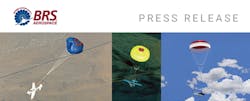BRS Aerospace Addressing Urban eVTOL Parachute Recovery Systems
South St. Paul, Minn., May 15, 2018 - BRS Aerospace is developing vehicle recovery systems technology that will allow electric-powered vertical takeoff and landing aircraft to reach safety levels equivalent to standards established in the automotive industry.
"Working with a number of new aircraft manufacturers, BRS Aerospace is at the early stages of creating technology that could make eVTOL (electric-powered Vertical TakeOff and Landing) aircraft a reality," said BRS Aerospace President/Director Enrique Dillon. "BRS Aerospace was represented at Uber Elevate as one of four critical gap technologies necessary for the successful development of the eVTOL ecosystem."
BRS Aerospace shared its existing whole aircraft recovery parachute technology with participants at the urban aviation summit, which discussed the future of air mobility in largely populated cities around the world. Other gap technologies, critical to the successful development of eVTOL transportation, included asymmetrical low noise rotors, avionics and electrical propulsion systems.
"Autonomous flight over highly populated urban environments is a challenge that will require a lot of work," Dillon said. "Safety both in the air and on the ground is not an option anymore, and we are not there yet. But I have no doubt that urban air mobility not too far from today will become a reality."
BRS Aerospace is the world leader in whole aircraft parachute systems with more than 35,000 systems delivered to aviation segments including Light Sport Aircraft, experimentals, ultralights, unmanned vehicles, military aircraft, and FAA/EASA Type Certified general aviation, including the most popular piston-powered aircraft in production today.
BRS Aerospace's current whole aircraft parachute system for fixed-wing aircraft design calls for a parachute ballistic launcher to be installed in the aircraft with either a pilot-initiated activator located in the cockpit or an automated activation system. Upon activation, a ballistic rocket propels a parachute into the airstream to slow the airplane and float it down into a survivable vertical landing.
The system is designed to be a last resort for pilots and passengers when all other attempts to recover the airplane in case of emergency or pilot incapacitation have failed. BRS Aerospace was founded in 1980 in South St. Paul, Minn.
It has manufacturing facilities at the South St. Paul Municipal Airport and in Pine Bluff, N.C. The system has been successfully deployed multiple times and the company has documented 380 lives saved as a result of its safety device. For more information go to www.brsaerosapce.com.
